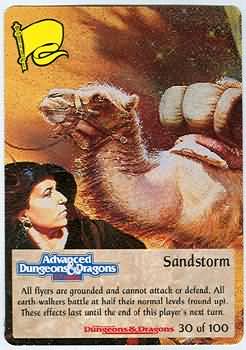
The greatest physical
danger in a sandstorm || dust storm (hereafter
referred to as a
sandstorm) is the chance of damage to
the eyes, with respiratory
damage a close second.
Any character who does
not take precautions to shield or cover
his eyes during a sandstorm may be blinded
(roll of 1 on 1d6) or
partially blinded (roll of 2 or 3 on 1d6).
This check is made once
every three rounds for as long as the
eyes remain unshielded. A
partially blinded character will automatically
become blinded
three rounds later if his eyes remain
unprotected and he does not
receive aid from someone else. An opponent
attacking a character
blinded from a sandstorm does so at +4
"to hit" and damage
with a melee weapon, or +4 "to hit" only
with a missile weapon.
An opponent attacking a character partially
blinded from a sandstorm
does so at +2 "to hit," regardless of
the weapon or attack
mode, but receives no bonus to damage.
A blinded character,
in this context, in not necessarily sightless;
he can distinguish light && movement,
but not with any
great degree of acuity or accuracy. A
blinded character cannot
attack (or, at the DM's option, he may
be allowed to wield his
weapon at a substantial penalty to hit
and damage), and can
move no more than 1/2 SPEED unless he
is being led by another
character. A partially blinded character
cannot successfully attack
in missile combat, attacks with a -2 penalty
on all other attack
rolls, and can MOVE at no more than 2/3
SPEED unless he is
being led by another character.
A character whose nose
and mouth are unprotected during a
sandstorm has a 1 in 6 chance per round
of going into a choking
fit. This does no damage initially, but
for anyone who suffers a
choking fit there is a 3 in 6 chance that
it will continue and worsen
in the following round, this time causing
1d3 points of damage
and forcing the character to take a -2
penalty on all attack rolls
and saving throws during this round. On
the third round, there is a
4 in 6 chance that the character will
become fully disabled. He
must make a STR Check to remain on his
feet, and if this
check succeeds he still suffers a -4 penalty
on all attack rolls
and saving throws during this round. On
the fourth round he will
fall to the ground, go into convulsions,
and begin to suffocate unless
he receives aid.
Several means are available to assist the
victim of a sandstorm,
including spells that can alleviate or
cure
blindness or suffocation.
Nonmagical means are covered here. Any
character,
including the victim himself, can aid
a blinded or partially blinded
victim by splashing water
into the victimís eyes; this will wash the
foreign substance out of the eyes, and
in 2-7 hours (ld6+1)
thereafter the victim will be recovered.
If the eyes are not washed
out, a partially blinded victim will recover
naturally in 12 hours. A
blinded victim whose eyes are not washed
out will recover to the
point of partial blindness in 24 hours,
but will require the aid of
magic or a character with healing proficiency
before his full vision
is restored. In all of these cases, whether
water is used or not, the
victimís eyes must be kept closed and
tightly covered for the duration
of the healing period. Any treatment will
be totally ineffective
if this requirement is not met.
Fallen snow that
is whipped up by a strong wind and driven
against characters
can cause partial blindness. When such conditions
exist, any character
whose eyes are not shielded from the
driving snow has
a 1 in 6 chance of suffering partial blindness
(this check should
be made every 3-5 rounds, depending on the
wind velocity).
This partial blindness is much less severe than
that caused by a
sandstorm: a victim will recover naturally in 1d6
turns, provided
that the eyes are kept shielded (but not necessarily
closed) for that
length of time. Nonmagical healing efforts
will
not hasten this
recovery process.